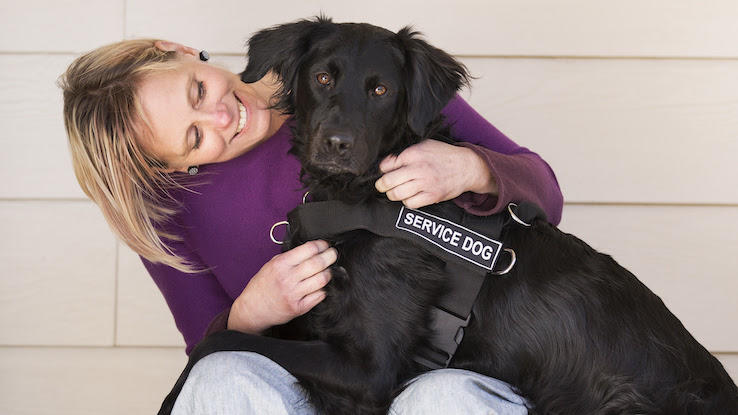How To Ask For An Emotional Support Animal

Many people with disabilities seek support from service animals. In add-on to providing companionship, service animals are trained to perform tasks, from providing stability to picking up items to alerting individuals about environmental hazards.
However, in recent years, emotional back up animals have as well become more prominent. While both offer support, there are stark differences between the two — especially when it comes to legal protections and training. Here, we'll delve into the differences between service animals and emotional support animals, from the types of services they provide to the training they require.
How Emotional Back up Animals Help People with Mental Illnesses and Disorders
An emotional back up animate being (ESA) is an animal companion that helps support an individual who is living with a mental illness or disorder. Most often, individuals ESAs are dogs, but other animals, from cats to miniature horses to lizards, can all provide emotional back up and companionship. By providing companionship, these animals provide a sense of comfort for people with anxiety or depression. ESAs tin can also help folks who experience panic attacks or who live with anxiety disorders, such every bit post-traumatic stress disorder (PTSD) or obsessive-compulsive disorder (OCD).

Under the Americans with Disabilities Act (ADA), emotional back up dogs are not technically considered service dogs. While ESAs tin be trained to back up their owner, they don't usually receive professional grooming, nor do they perform item tasks. That is, providing comfort, while of import, doesn't qualify as a service.
While ESAs no longer have legal protections on airplanes, many can receive certifications so that there's no disharmonize with an individual's housing situation. Moreover, psychiatric service dogs, who are trained to perform tasks that mitigate a person'due south psychiatric condition, such as PTSD, differ from ESAs and have more than protections.
Legal Protection Is Express for an Emotional Support Animal (ESA)
With emotional support animals becoming more common, patients often request letters of documentation supporting their need for an brute from their psychologist, therapist, or doctor. This official documentation of diagnosis is helpful to have on hand as validation, simply, unfortunately, ESAs and their owners still face limited legal protections and rights in public places.

While the ADA covers trained, professional person service animals, it does not extend to emotional support animals. In practice, this means that individuals with ESAs don't have unlimited admission to public spaces. Depending on their own policies, businesses reserve the right to deny services to those with emotional support animals. As of January 2021, airlines are no longer required to arrange ESA owners, for example.
However, the Fair Housing Deed (FHA) requires landlords to permit renters to keep emotional support animals in their residence — fifty-fifty if pets aren't allowed in the building. Under the FHA, landlords or belongings owners cannot crave tenants to pay additional fees for ESAs. Additionally, they can't inquire for extensive information about a person'south inability or asking their medical records, nor can they crave that the brute have specific grooming.
Training Is a Must for Service Animals
Unlike ESAs, service animals are individually trained to perform specific tasks for people with physical, sensory, psychiatric, intellectual, and/or mental disabilities. For example, guide dogs aid blind and low-vision individuals navigate public spaces equally well as their homes. Service animals can also assist open doors, carry items and reach objects their owners may not be able to reach. Some of these trained animals tin can recognize the signs of seizures and will stand guard over their possessor or try and observe them help.

The Americans with Disabilities Human activity (ADA) does not require service dogs to exist professionally trained, though it'south certainly helpful. Individuals with disabilities tin can train their animals themselves, but sometimes professional training tin become a long fashion. Subsequently all, it'southward important for service animals to remain at-home, warning, and reliable, especially in unfamiliar settings.
Again, most service animals are dogs, and information technology can take upwardly to ii years for a dog to exist considered "properly trained" every bit a service fauna. If you demand aid finding a service dog, service dog agencies can assistance you observe an creature whose grooming aligns with the support yous need. In public spaces, some service animals may wear special vests, harnesses, collars, or tags that identify their status as working dogs.
Service Animals Have Legal Protections
Under the Americans with Disabilities Act, service animals accept many more legal protections than emotional support animals. Namely, this is considering service animals are needed throughout the day to help with concrete tasks. Every bit a result, these animals go pretty much anywhere without the fear of being denied access.

Yes, service animals can be brought into restaurants, stores, libraries, and other public spots, even if pets aren't allowed. Service animals are fifty-fifty permitted on flights — though, typically, they must sit on the traveler's lap or at their feet. Though these animals tin can certainly be affectionate companions, they aren't exactly pets. After all, service animals are working animals, and they accept very important jobs to exercise.
Merely like with emotional support animals, individuals with service animals tin acquire certifications wherein a dr. or mental wellness professional writes a alphabetic character that states their diagnosis and the way an animal will exist beneficial.
Dog Breeds That Brand Great Emotional Support and Service Animals
Certain dog breeds make great emotional support and/or service animals based on their dispositions. Labrador retrievers, for example, are one of the nearly popular dog breeds when it comes to providing assist, namely because they are naturally friendly, obedient and helpful. As you might expect, gilded retrievers are much the same.

Although known for being protective guard dogs, German shepherds also make great service animals. Well-behaved and easy to train, their size, forcefulness, and attention to detail make them a keen choice. Another great selection? The border collie. This intelligent herding breed enjoys being given a chore, though they may have a little more than backlog free energy than the other breeds on this listing.
Resource Links:
- "How Long Does information technology Have to Train a Service Dog?" via Official Service Canis familiaris, Therapy Domestic dog & Emotional Back up Animate being Registry
- "Which Breeds Make the All-time Service Dogs?" via K9 of Mine
- "Service Dogs, Working Dogs, Therapy Dogs, Emotional Support Dogs: What's the Difference?" via American Kennel Club (AKC)
- Ofttimes Asked Questions (FAQ) | The Americans with Disabilities Human activity (ADA) via The U.S. Department of Justice
- "No, the Fair Housing Act of 1968 Didn't End Housing Discrimination in the U.South." via Reference
Source: https://www.symptomfind.com/healthy-living/emotional-support-animal-vs-service-animal?utm_content=params%3Ao%3D740013%26ad%3DdirN%26qo%3DserpIndex
Posted by: rosssoombeark.blogspot.com

0 Response to "How To Ask For An Emotional Support Animal"
Post a Comment